AUDI A5 COUPE 2011 Owners Manual
Manufacturer: AUDI, Model Year: 2011, Model line: A5 COUPE, Model: AUDI A5 COUPE 2011Pages: 362, PDF Size: 84.88 MB
Page 181 of 362
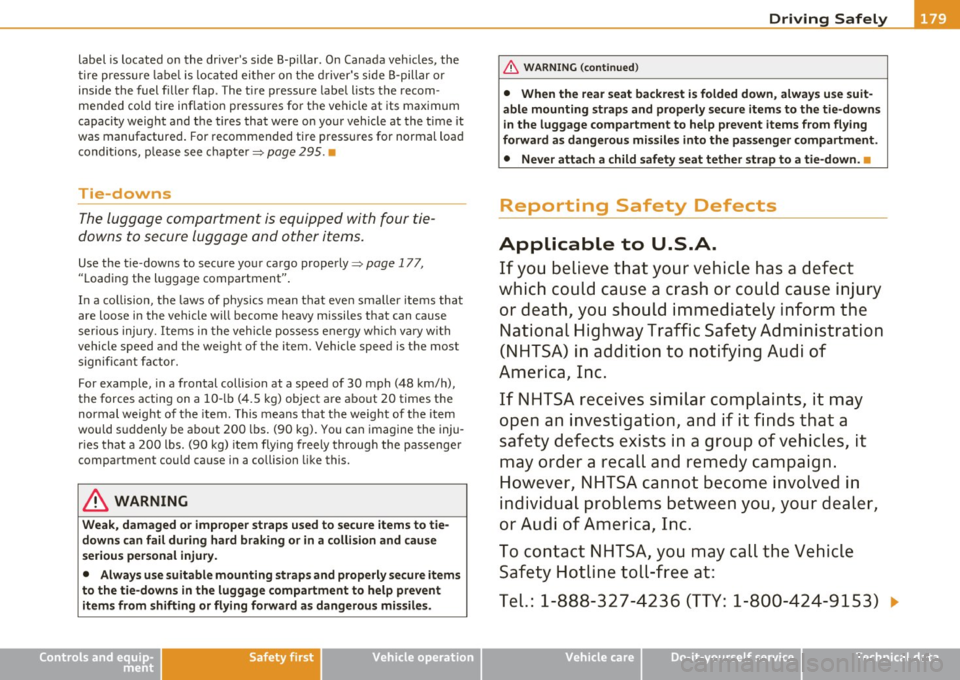
______________________________________________ D_ ri _v _ i_n _,,g ~ S_a_ f_ e_ l_,, y '--- __
label is located on the driver's side 8-p illar . On Canada veh icles, the
ti re pressu re lab el is loca ted ei ther on the d river's s ide 8-pillar or
inside the fuel fille r flap . The tire pressure label lists the recom
mended co ld tire inflatio n pressures fo r the ve hicle at its maximum
capacity weight and the tires that were on yo ur vehicle at the t ime it
was manufactured . For recommended tire pressures for normal loa d
c ondi tions, p lease see chapte r=>
page 295. •
Tie-downs
The luggage compartment is equippe d with four tie
d o w ns to secu re lu ggage and other i tems.
Use the t ie-downs to sec ure yo ur ca rgo prope rly=> page 177 ,
"Load ing the luggage compartment" .
In a c oll ision, t he laws of physics mean that eve n small er item s tha t
are loose in the vehicle will become heavy missiles that can cause
s er iou s injury. Ite ms i n t he vehi cle p osses s ene rgy w hich vary w it h
vehicle speed and the weight of the item. Vehicle speed is th e most
sig nifi ca nt fa ctor.
For examp le, in a frontal collis ion at a speed of 30 mph (4 8 km/h) ,
the forces acting on a 10- lb (4.5 kg) object are a bout 20 times the
normal weig ht o f th e ite m. Th is mea ns that t he weight of t he ite m
wou ld s uddenly be abo ut 200 lbs. (90 kg) . You can imagine the inju
r ies tha t a 200 lbs . (9 0 kg) item fly ing freely throug h the pa ssenge r
compartment could cause in a collision like this.
& WARNING
Weak , damaged or improper straps used to secure items to tie
downs can fail during hard braking or in a collision and cause
serious personal inju ry.
• Always use suitable mounting straps and properly secure items
to the tie-downs in the luggage compartment to help prevent
items from shifting or flying forward as dangerous missiles.
Controls and equip ment Safety first Vehicle operation
& WARNING
(co ntinued )
• When the rear seat backrest is folded down, always u se suit
able mounting straps and properly secure items to the tie-downs
in the luggage compartment to help p revent items from flying
forward as dangerous missiles into the passenger compartment .
• Never attach a child safety seat tether strap to a tie-down. •
Reporting Safety Defects
Applicable to U.S.A.
If you believe that your vehi cle has a defect
which could cause a crash or could cause injury or death , you should immediately inform the
National Highway Traffic Safety Administration
(NHTSA) in addition to notifying Audi of
America, Inc.
If NHTSA receives similar complaints, it may
open an investigation , and if it finds that a
safety defe cts exist s in a group of vehicles, it
may o rder a recall and remed y campaign.
However, NHTSA cannot become involved in
individual problems between you , your dealer,
or Audi of America, Inc .
To contact NHTSA, you m ay call the Vehicle
Safety Hotline toll-free at:
Tel.: 1-888-327-4236 (TTY: 1-800-424-9153) _,.
Vehicle care Do-it-yourself service Technical data
Page 182 of 362
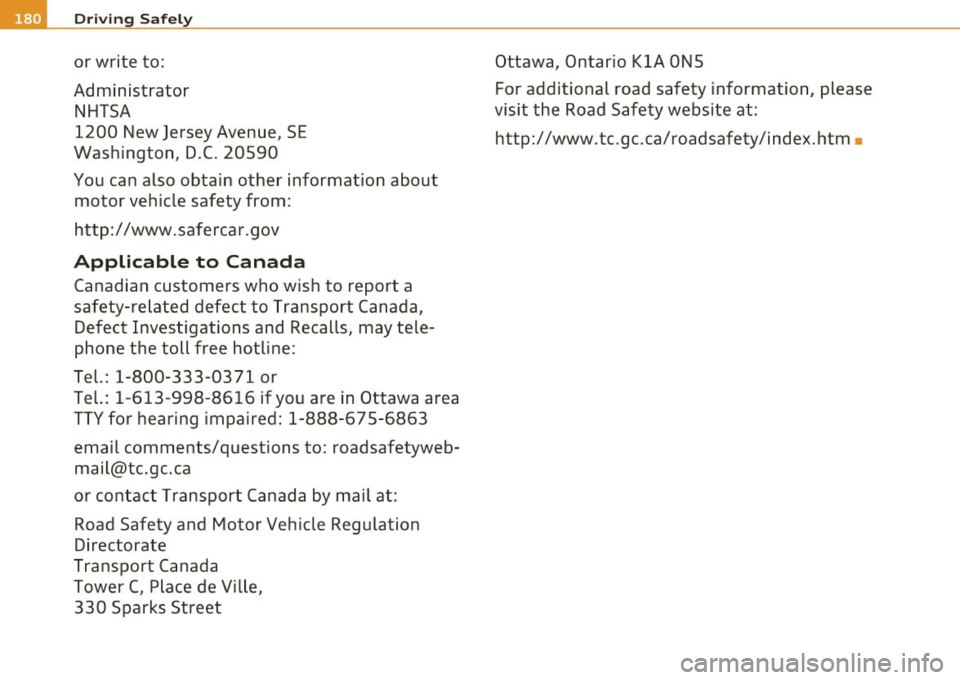
ffl Driv ing Sa fely
or write to:
Administrator NHTSA
1200 New Jersey Avenue, SE
Washington, D.C . 20590
You can also obtain other information about motor vehicle safety from :
http:/ /www .safercar.gov
Applicable to Canada
Canadian customers who wish to report a
safety -related defect to Transport Canada ,
Defect Investigations and Recalls, may tele
phone the toll free hotline:
Tel.: 1-800-333-0371 or
T el. : 1-613-998-8616 if you are in Ottawa area
T TY for hearing impaired: 1-888-675 -6863
email comments/questions to: roadsafetyweb
[email protected]
or con tact Transport Canada by mail at:
Road Safety and Motor Veh icle Regulation
Directorate
Transport Canada
T ower C, P lace de Ville,
330 Sparks Street Ottawa, Ontario KlA ON5
For additional road safety information, please
visit the Road Safety website at:
http ://www .tc .gc.ca/roadsafety/index.htm •
Page 183 of 362
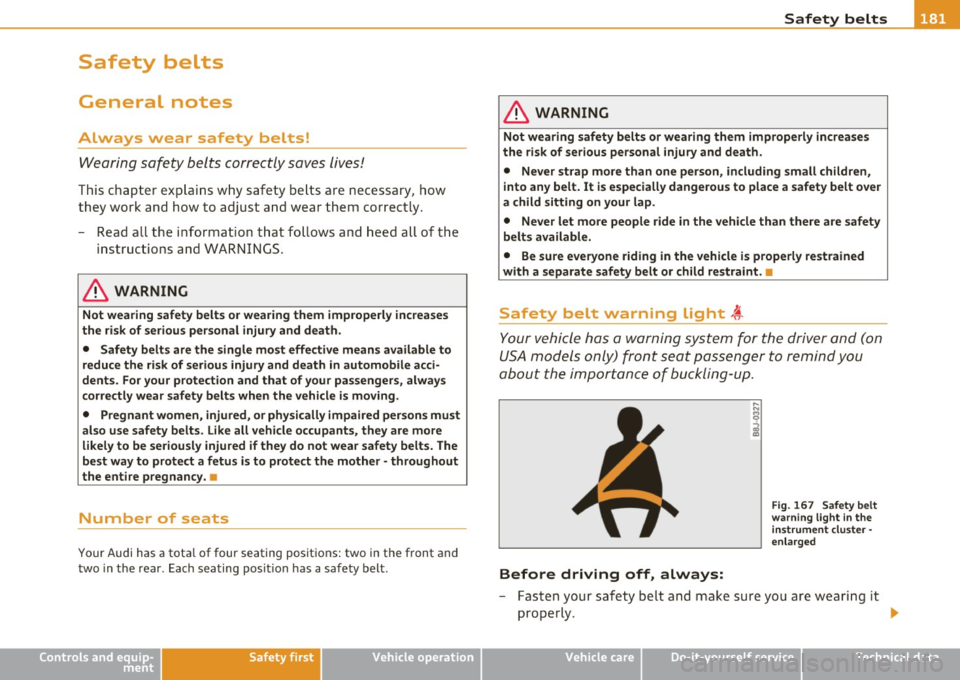
_____________________________________________ S_a _f _e _t _y _b_ e_lt _ s __ _
Safety belts
General notes
Always wear safety belts!
Wearing safety belts correctly saves lives!
This chapter explains why safety belts are necessary, how
they work and how to adjust and wear them correctly.
- Read all the information that follows and heed all of the
instructions and WARNINGS.
& WARNING
Not wearing safety belts or wearing them improperly increases
the risk of serious personal injury and death.
• Safety belts are the single most effective means available to
reduce the risk of serious injury and death in automobile acci
dents. For your protection and that of your passengers, always
correctly wear safety belts when the vehicle is moving.
• Pregnant women, injured, or physically impaired persons must
also use safety belts. Like all vehicle occupants, they are more
likely to be seriously injured if they do not wear safety belts. The
best way to protect a fetus is to protect the mother -throughout
the entire pregnancy. •
Number of seats
Your Audi has a total of four seating positions: two in the front and
two in the rear . Each seating position has a safety belt .
Controls and equip
ment Safety first Vehicle operation
& WARNING
Not wearing
safety belts or wearing them improperly increases
the risk of serious personal injury and death.
• Never strap more than one person, including small children,
into any belt. It is especially dangerous to place a safety belt over
a child sitting on your lap.
• Never let more people ride
in the vehicle than there are safety
belts available.
• Be sure everyone riding in the vehicle is properly restrained
with a separate safety belt or child restraint. •
Safety belt warning light t
Your vehicle has a warning system for the driver and (on
USA models only) front seat passenger to remind you
about the importance of buckling-up.
Before driving off, always:
Fig. 167 Safety belt
warning light in the
instrument cluster -
enlarged
- Fasten your safety belt and make sure you are wearing it
properly .
IJ,,
Vehicle care Do-it-yourself service Technical data
Page 184 of 362
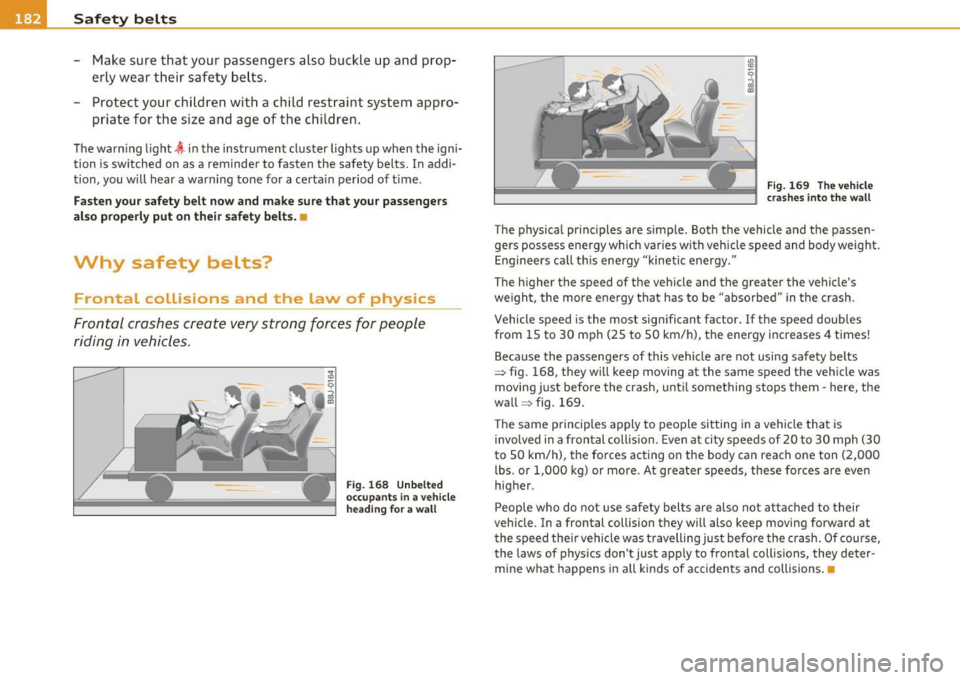
___ S_a_ f_ e_ t-= y'-- b_e_ l_ t _s _____________________________________________ _
- Make sure that your passengers also buckle up a nd prop
erly wear their safety belts .
- Protect your children wi th a child restraint system appro-
p ria te for the siz e and age of th e ch ild ren.
The warn ing light ~ in the instrument cluster lights up when the igni
tion is sw itched on as a reminder to fasten the safety belts. In addi
tion, you w ill hear a wa rning tone for a certa in period of t im e.
Fasten your safety belt now and m ake sure that your passengers
also properly put on their safety belt s.•
Why safety belts?
Frontal collisions and the Law of physics
Frontal crashes c reate very s trong f orces for people
riding in vehicles.
Fig . 16 8 Unbelted
occu pa nt s in a v ehi cle
h ea ding f or a w all Fig. 169 Th
e veh icl e
c ra she s into the wall
The p hys ica l pr inc iples are simple. Both the vehicle and the passen
gers possess energy wh ich var ies wit h veh icle speed and body weight.
Enginee rs call th is ene rgy "kinetic energy."
The higher the speed of the veh icle and the greater the vehicle's
we igh t, the more e ne rgy tha t has to be "abso rbed" in t he crash.
Vehicle speed is the most sign ificant factor.
If the speed doubles
from 15 to 30 mph (25 to 50 km/h), the energy increases 4 t imes!
Because the passenge rs of this vehicle a re not using safety belts
=> fig. 168, they w ill keep moving at the same speed the vehicle was
moving j ust before the crash, unt il some thing stops them· here, the
wall => fig . 169 .
Th e same principles apply to people sitting in a vehi cle that is
involved in a frontal collision . Even at city speeds of 20 to 30 mph (30
to 50 km/h), the forces acting on the body ca n reach one ton (2,000
lbs . or 1,000 kg) or mo re . At greate r speeds, these forces are eve n
higher.
People who do not use safety bel ts are also not at ta ched to their
vehicle . In a frontal collision they will also keep moving forward at
t he speed the ir veh icle w as t ravelling just befo re the crash. O f course,
the laws of p hys ics don 't just apply to frontal collis ions, they deter
mine wha t happens in a ll kinds of accidents and collisions .•
Page 185 of 362
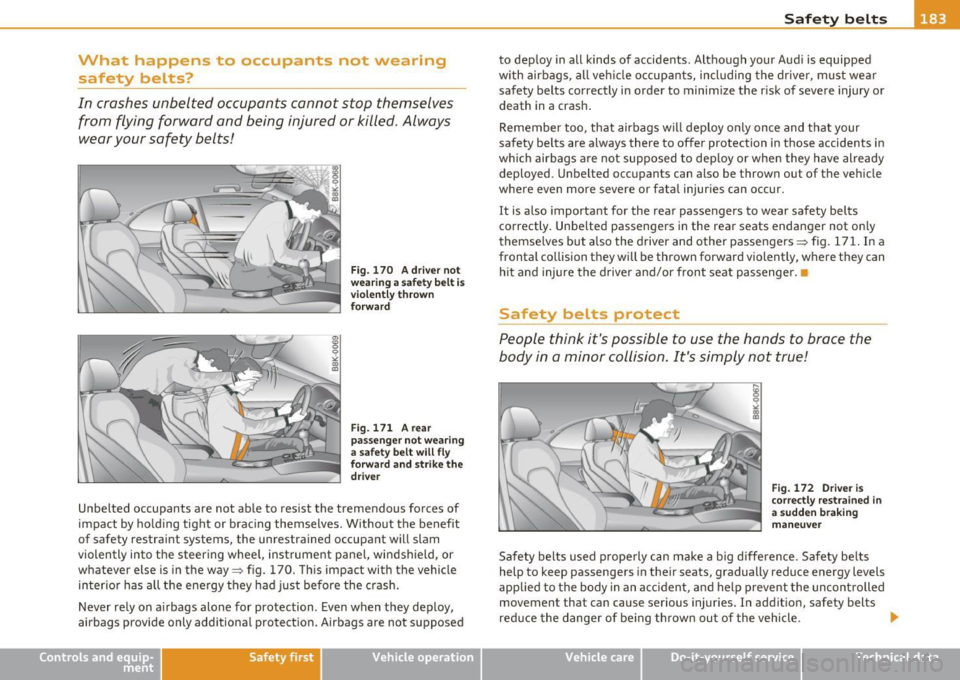
What happens to occupants not wearing
safety belts?
In crashes unbelted occupants cannot stop themselves from flying forward and being injured or killed. Always
wear your safety belts!
Fig. 170 A driver not
wearing a safety belt is
violently thrown
forward
Fig. 171 A rear
passenger not wearing
a safety belt will fly
forward and strike the
driver
Unbelted occupants are not able to resist the tremendous forces of
impact by holding tight or bracing themselves. Without the benefit
of safety restraint systems, the unrestrained occupant will slam
violently into the steering wheel, instrument panel, windshield, or
whatever else is in the way=:> fig. 170. This impact with the vehicle
interio r has all the energy they had just before the crash.
Never rely on airbags alone for protection . Even when they deploy,
airbags provide only additional protection. Airbags are not supposed
Safety first Vehicle OP-eration
Safety belts
to deploy in all kinds of accidents. Although your Audi is equipped
with airbags, all vehicle occupants, including the driver, must wear
safety belts correctly in order to minimize the risk of severe injury or
death in a crash.
Remember too, that airbags will deploy only once and that your
safety belts are always there to offer protection in those accidents in
which airbags are not supposed to deploy or when they have already
deployed . Unbelted occupants can also be thrown out of the vehicle
where even more severe or fatal injuries can occur.
It is also important for the rear passengers to wear safety belts
correctly. Unbelted passengers in the rear seats endanger not only
themselves but also the driver and other passengers=:> fig . 171. In a
frontal collision they will be thrown forward violently, where they can
hit and injure the driver and/or front seat passenger. •
Safety belts protect
People think it's possible to use the hands to brace the
body in a minor collision. It's simply not true!
Fig. 172 Driver is
correctly restrained in
a sudden braking
maneuver
Safety belts used properly can make a big difference. Safety belts
help to keep passengers in their seats, gradually reduce energy levels
applied to the body in an accident, and help prevent the uncontrolled
movement that can cause serious injuries. In addition, safety belts
reduce the danger of being thrown out of the vehicle. .,.
Vehicle care Do-it-yourselt service iTechnical data
Page 186 of 362

___ s_a_ f_ e_ t_ y _ b_e _l_t _s ___________________________________________ _
Safety be lts attach passe ngers to t he car an d give th em the benef it of
b ei ng s lo we d d own mor e gentl y or "so ftly" throu gh th e "give" in the
sa fety bel ts, crush z ones a nd oth er safety feat ures engin eered in to
today 's vehicles . By "absor bing" the kinetic e ner gy over a lo ng er
p eriod of time, th e saf ety belts make the forces o n th e body mor e
"to lerable" and less likely to ca use inju ry .
Alt hou gh the se ex amp les a re based on a fr ontal col lis ion, safety bel ts
can a lso s ubstantially red uce the risk of in jur y in other ki nds of
cras hes. So , whe ther you 're o n a long tri p o r ju st go in g to th e co rner
sto re, a lways b uckle up a nd make sure others do, too. Accident statis
t ics s how t hat vehi cle occupan ts properly wea rin g safety belts have a
lower risk of bei ng in jured and a muc h better cha nce of s urvivi ng an
acc ident. Properly usi ng safety belts also greatly increases the ability
of the supp lemental a irbags to do t heir job in a co llisio n. For this
reason, wea ring a safety belt is lega lly re quir ed in most countries
including muc h of th e Uni ted Stat es and Canad a.
Altho ugh your Audi is equipped with a irbags, yo u still have to wear
t he s afety bel ts provi ded. Fr ont airba gs, for ex ample, are activ ated
only in some fro nta l collisions . T he front a irbags are not activated in
all fr ont al collis ions, in side and re ar co llisions, in ro ll overs or in cases
w her e th er e is no t enough d ecelerat io n t hroug h im pac t to th e fron t
o f th e ve hicle. T he same goes for the ot he r air bag sys tems in yo ur
Audi. So, always wear your saf ety be lt and make sure eve rybody in
your vehicle is properly restrai ned! •
Important safety instructions about safety
belts
S afety bel ts m ust alw ays b e co rre ctly po sitio ned a cross
t he str ongest bones o f your bo dy.
- Al ways we ar saf ety be lts as illustra te d an d descri bed i n
this c hapter.
- M ake sure that your s afet y be lts are alw ays re a dy f or use
a nd a re n ot d amaged .
& WARNING
Not wearing safety belts or wearing them improperly increases
the risk of serious personal injury and death. Safety belts can work only when used correctly.
• Always fasten your safety belts correctly before driving off and
make sure all passengers are correctly restrained.
• For maximum protection , safety belts must always be posi
tioned properly on the body.
• Never strap more than one person, including small children,
into any belt.
• Never place a safety belt over a child sitting on your lap.
• Always keep feet in the footwell in front of the seat while the
vehicle is being driven.
• Never let any person ride with their feet on the instrument
panel or sticking out the window or on the seat.
• Never remove a safety belt while the vehicle is moving. Doing
so will increase your risk of being injured or killed.
• Never wear belt s twisted .
• Never wear belts over rigid or breakable objects in or on your
clothing, such as eye glasses, pens, keys, etc., as these may cause
injury .
• Never allow safety belts to become damaged by being caught
in door or seat hardware.
• Do not wear the shoulder part of the belt under your arm or
otherwise out of position.
• Several layers of heavy clothing may interfere with correct
positioning of belts and reduce the overall effectiveness of the
system .
• Always keep belt buckles free of anything that may prevent the
buckle from latching securely . .._
Page 187 of 362
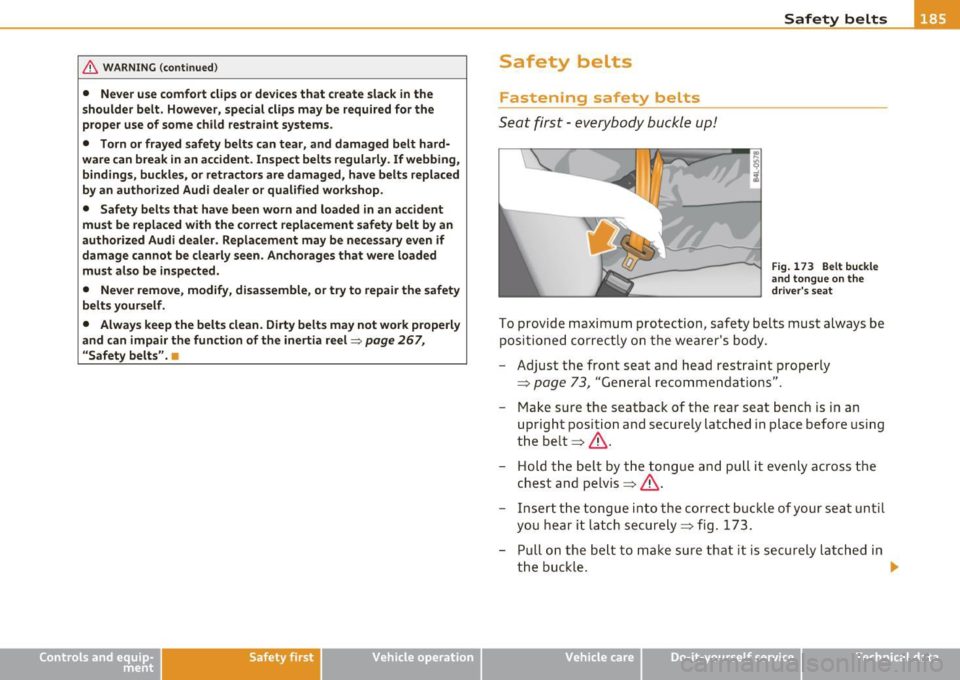
& WARNING (continued)
• Never use comfort clips or devices that create slack in the
shoulder belt. However, special clips may be required for the
proper use of some child restraint systems.
• Torn or frayed safety belts can tear, and damaged belt hard
ware can break in an accident. Inspect belts regularly. If webbing,
bindings, buckles, or retractors are damaged, have belts replaced
by an authorized Audi dealer or qualified workshop.
• Safety belts that have been worn and loaded
in an accident
mu st be replaced with the correct replacement safety belt by an
authorized Audi dealer. Replacement may be necessary even if
damage cannot be clearly seen. Anchorages that were loaded
must also be inspected.
• Never remove, modify, disassemble, or try to repair the safety
belts yourself.
• Always keep the belts clean. Dirty belts may not work properly
and can impair the function of the inertia reel=>
page 267,
"Sa fety belts". •
Safety first Vehicle OP-eration
Safety belts
Fastening safety belts
Seat first -everybody buckle up!
Safety belts
Fig. 173 Belt buckle
and tongue on the
driver's seat
To provide maximum protection, safety belts must always be
pos itioned correctly on the wearer's body.
- Adjust the front seat and head restraint properly
=> page 73, "General recommendations" .
- Make sure the seatback of the rear seat bench is in an
upr ight position and securely latched in place before using
the belt => & .
- Hold the belt by the tongue and pull it evenly across the
chest and pelvis =>& .
- Insert the tongue into the correct buckle of your seat until
you hear it latch securely => fig. 173.
- Pull on the belt to make sure that it is securely latched in
the buckle.
II>
Vehicle care Do-it-yourselt service iTechnical data
Page 188 of 362
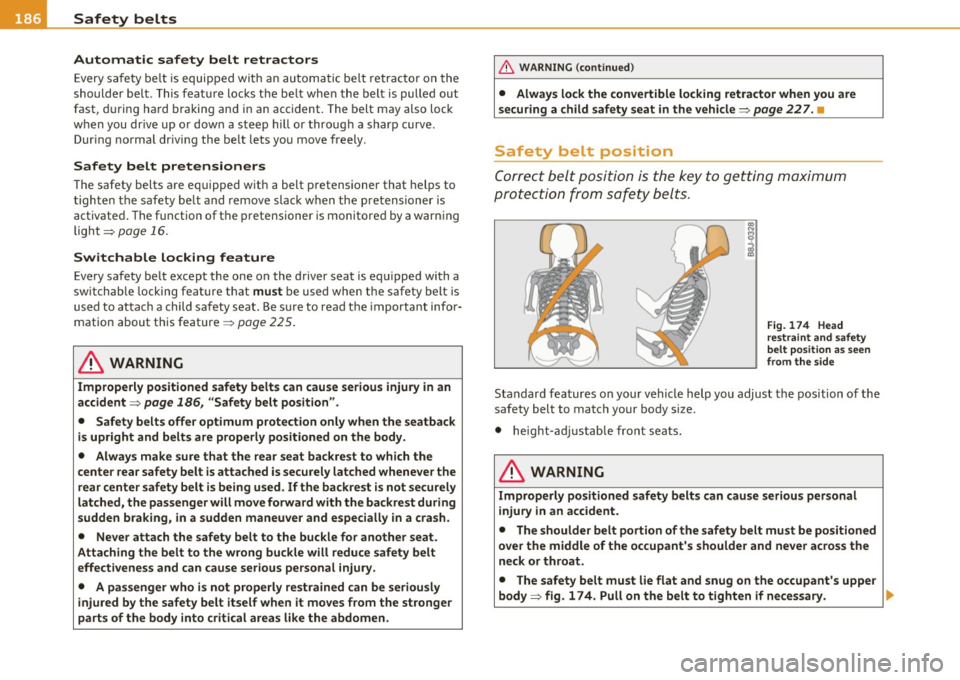
___ s_a_ f_ e_ t_ y _ b_e _l_t _s ___________________________________________ _
Automatic safety belt retractors
Every safe ty be lt is equipped with an automatic be lt retractor on the
shoulder belt . This feat ure locks t he be lt whe n the belt is pulled out
fast, d uring ha rd braking and in an accident. The belt may also lock
w hen you dr ive up or dow n a steep hill or throug h a sharp curve .
Dur ing norma l driv ing the belt lets you move freely.
Safety belt pretensioners
T he safety belts are eq uipped w ith a belt p retensioner that helps to
tighten the safety belt and remove slac k w hen the p retensioner is
activated . The f unction of the p retens ioner is monitored by a warn ing
light=>
page 16.
Switchable locking feature
E very safety be lt except the one on the driver seat is equipped with a
switchab le locking feature that
must be used when the safety belt is
used to attach a child safety seat. Be sur e to read t he importa nt info r
mation about this feature=>
page 225.
& WARNING
Improperly po sitioned safety belt s can cau se serious injury in an
accident =>
page 186, "Safety b elt position ".
• Safety belts offer optimum protection only when the seatback
is upright and belts are properly posit ioned on the body .
• Alway s make sure that the r ear seat backre st to which the
center rear safety belt is attached is se curely latched whene ver the
rear center safety belt is being u sed . If the ba ckre st is not securely
latched, the passenger will move forwa rd with the backrest during
sudden braking, in a sudden maneuve r and e specially in a crash.
• Never attach the safety belt to the buckle for another seat .
Attaching the belt to the wrong bu ckle will reduc e safety belt
effect iveness and can cause serious personal injury .
• A passenger who i s not properly restrained can be seriou sly
injured by the safety belt itself when it moves from the stronger
parts of the body into critical area s like the abdomen.
& WARNING (c on tinued )
• Alway s lock the convertible locking retractor when you are
securing a child safety seat in the vehicle=>
page 227. •
Safety belt position
Co rrect bel t posi tion is the key to get ting maximum
pro tec tion f rom safety belts .
Fig. 174 H ead
res traint a nd safety
belt po sit io n a s se en
from the side
Standard features on your vehicle help you adjust th e position of the
safety belt to match your body si ze.
• height-ad justable fron t sea ts.
& WARNING
Improperly po sitioned safety belts can cau se serious per sonal
i njury in an accident.
• The shoulder belt portion of the safety be lt must b e position ed
over the middle of the occupant's shoulder and never acro ss the
neck or throat.
• The safety belt must lie flat and snug on the occupant's upper
body => fig. 174. Pull on the belt to tighten if neces sary. .,,,.
Page 189 of 362
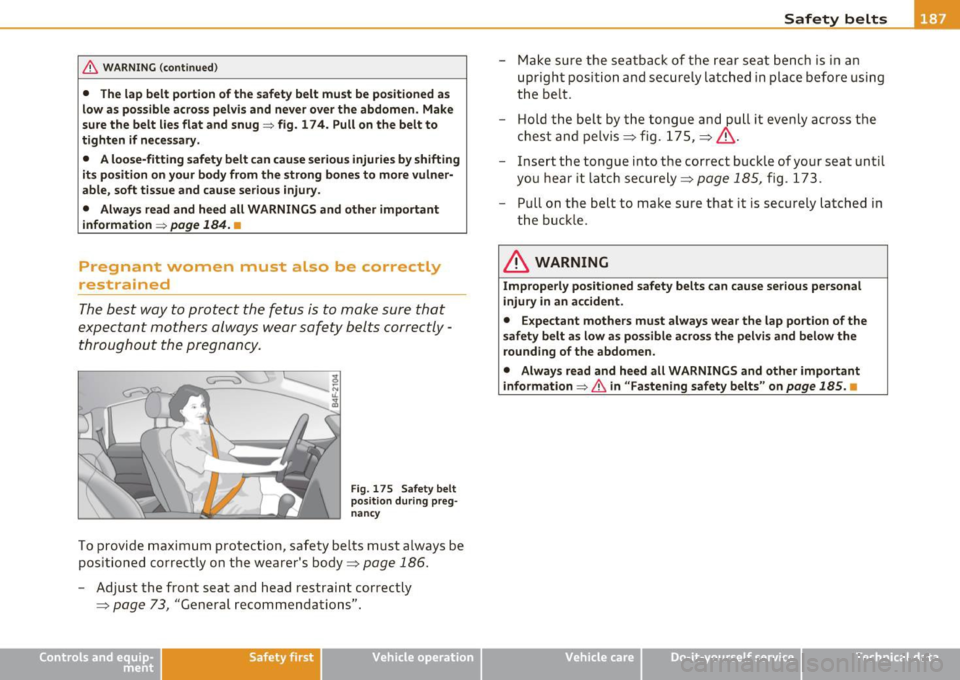
& WARNING (continued)
• The lap belt portion of the safety belt must be positioned as
low as possible across pelvis and never over the abdomen. Make
sure the belt lies flat and snug=> fig. 174. Pull on the belt to
tighten if necessary.
• A loose-fitting safety belt can cause serious injuries by shifting
its position on your body from the strong bones to more vulner
able, soft tissue and cause serious injury.
• Always read and heed all WARNINGS and other important
information
=> page 184 . •
Pregnant women must also be correctly
restrained
The best way to protect the fetus is to make sure that
expectant mothers always wear safety belts correctly -
throughout the pregnancy.
Fig. 175 Safety belt
position during preg
nancy
To provide maximum protection, safety belts must always be
positioned correctly on the wearer's body~
page 186.
-Adjust the front seat and head restraint correctly
~ page 73, "General recommendations".
Safety first Vehicle OP-eration
Safety belts
-Make sure the seatback of the rear seat bench is in an
upright position and securely latched in place before using
the belt.
- Hold the belt by the tongue and pull it evenly across the
chest and pelvis~ fig. 175,
~ &-
- Insert the tongue into the correct buckle of your seat until
you hear it latch securely ~
page 185, fig. 173 .
- Pull on the belt to make sure that it is securely latched in
the buckle.
& WARNING
Improperly positioned safety belts can cause serious personal
injury in an accident.
• Expectant mothers must always wear the lap portion of the
safety belt as low as possible across the pelvis and below the
rounding of the abdomen.
• Always read and heed all WARNINGS and other important
information => & in "Fastening safety belts" on page 185. •
Vehicle care Do-it-yourselt service iTechnical data
Page 190 of 362
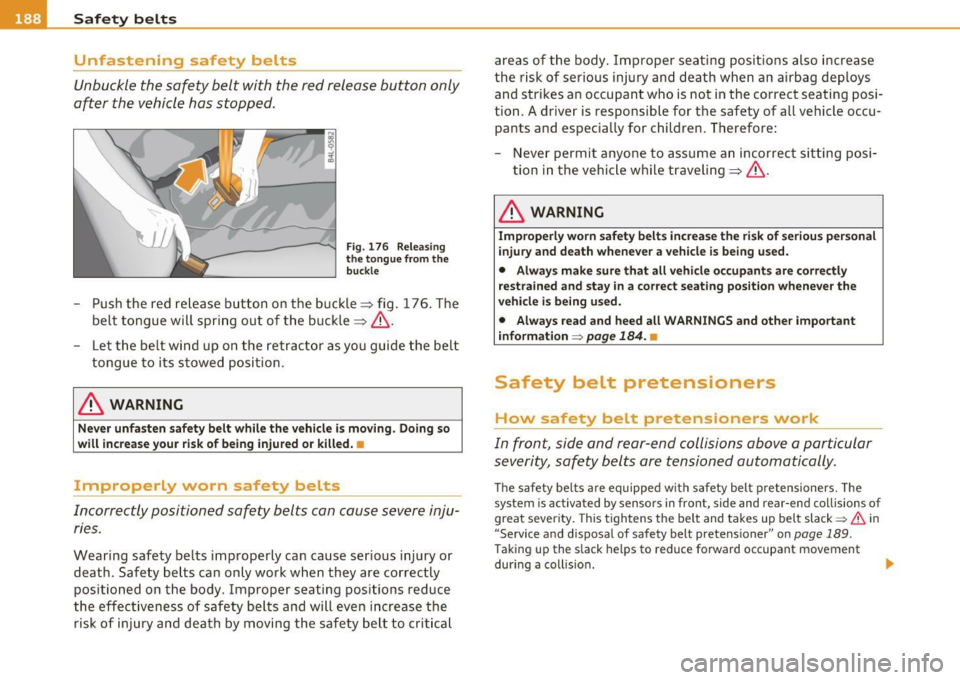
___ S_a _f_e _t-= y '-- b_e_ l_ t _s _____________________________________________ _
Unfastening safety belts
Unbuckle the safety belt with the red release button only
after the vehicle has stopped.
Fig . 176 Releasing
the tongue from the
buckle
- Push the red release button on the buckle=> fig. 176. The
belt tongue will spring out of the buckle=>& .
- Let the belt wind up on the retractor as you guide the belt tongue to its stowed position.
& WARNING
Never unfasten safety belt while the vehicle is moving. Doing so
will increase your risk of being injured or killed. •
Improperly worn safety belts
Incorrectly positioned safety belts can cause severe inju
ries.
Wearing safety belts improperly can cause serious injury or
death. Safety belts can only work when they are correctly
positioned on the body. Improper seating positions reduce
the effectiveness of safety belts and will even increase the
risk of injury and death by moving the safety belt to critical areas of the
body. Improper seating positions also increase
the risk of serious injury and death when an airbag deploys
and strikes an occupant who is not in the correct seating posi
tion. A driver is responsible for the safety of all vehicle occu pants and especially for children. Therefore:
- Never permit anyone to assume an incorrect sitting posi
tion in the vehicle while traveling=>&.
& WARNING
Improperly worn safety belts increase the risk of serious personal
injury and death whenever a vehicle is being used.
• Always make sure that all vehicle occupants are correctly
restrained and stay in a correct seating position whenever the
vehicle is being used.
• Always read and heed all WARNINGS and other important
information ~
page 184. •
Safety belt pretensioners
How safety belt pretensioners work
In front, side and rear-end collisions above a particular
severity, safety belts are tensioned automatically .
The safety belts are equipped with safety belt pretensioners. The
system is ac tivated by sensors in fron t, side and rear-end collisions of
great severity. This tightens the belt and takes up belt slack~
& in
"Service and disposal of safety belt pretensioner" on
page 189 .
Taking up the slack helps to reduce forward occupant movement
during a collision. .,